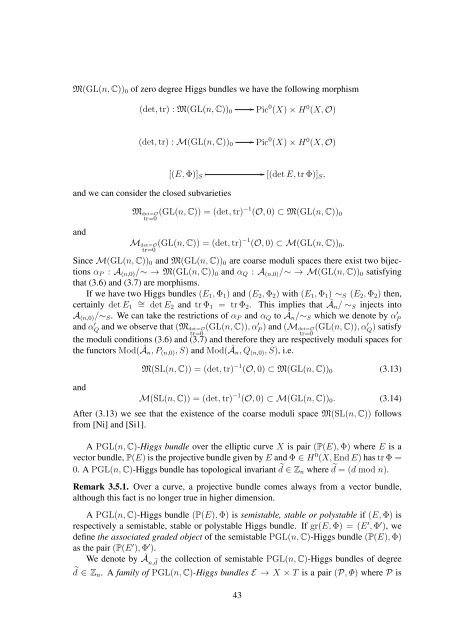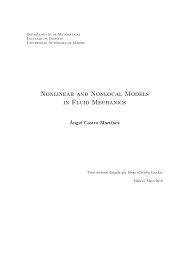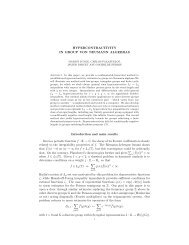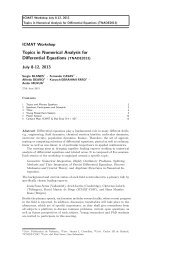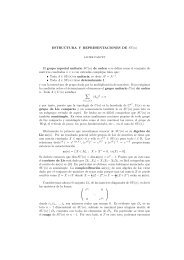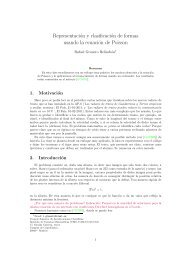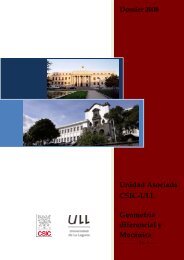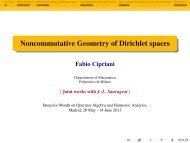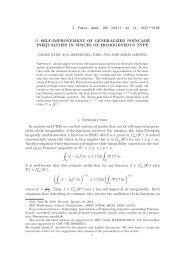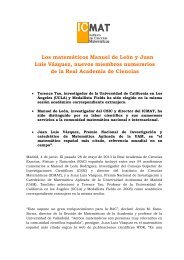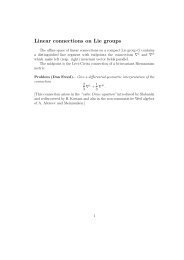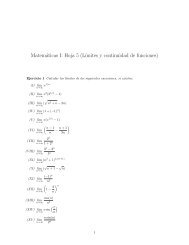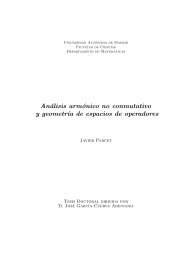3.5 SL(n, C) and PGL(n, C)-<strong>Higgs</strong> <strong>bundles</strong>A SL(n, C)-<strong>Higgs</strong> bundle <strong>over</strong> the <strong>elliptic</strong> curve X is a <strong>Higgs</strong> bundle (E, Φ) with trivialdeterminant and traceless <strong>Higgs</strong> field, i.e. det E ∼ = O tr Φ = 0. A SL(n, C)-<strong>Higgs</strong> bundle(E, Φ) is semistable, stable or polystable if (E, Φ) is respectively a semistable, stable orpolystable <strong>Higgs</strong> bundle.A Jordan-Hölder filtration of the semistable SL(n, C)-<strong>Higgs</strong> bundle (E, Φ) is a Jordan-Hölder filtration of (E, Φ) as a <strong>Higgs</strong> bundle and its associated graded object gr(E, Φ) isthe associated graded object of (E, Φ) as a <strong>Higgs</strong> bundle.We denote by Ân the collection of semistable SL(n, C)-<strong>Higgs</strong> <strong>bundles</strong>, we see that n is the subset of A n,0 given by the <strong>Higgs</strong> <strong>bundles</strong> with trivial determinant and traceless<strong>Higgs</strong> field. A family of SL(n, C)-<strong>Higgs</strong> <strong>bundles</strong> E → X × T is a family of <strong>Higgs</strong> <strong>bundles</strong>E = (V, Φ) such that for every t ∈ T we have det V t∼ = OX×{t} and tr Φ t = 0, i.e. thealgebraic condition is P (n,0) .Two semistable SL(n, C)-<strong>Higgs</strong> <strong>bundles</strong> (E 1 , Φ 1 ) and (E 2 , Φ 2 ) are S-equivalent if wehave that (E 1 , Φ 1 ) and (E 2 , Φ 2 ) are S-equivalent <strong>Higgs</strong> <strong>bundles</strong>. Again, we define S-equivalence for families pointwise. Once we have introduced all this notation we canconsider the following moduli functorMod(Ân, P (n,0) , S).We use M(SL(n, C)) to denote the coarse moduli space associated to this moduli problem,its existence will be discussed later.We write Âst n fot the subcollection of stable SL(n, C)-<strong>Higgs</strong> <strong>bundles</strong>. If two stable<strong>Higgs</strong> <strong>bundles</strong> are S-equivalent then they are isomorphic. This implies that S-equivalencefor families is equal to isomorphism pointwise and therefore we can define the followingmoduli functorMod(Âst n , P (n,0) , ∼ pt=).This moduli functor possesses a moduli space M st (SL(n, C)), which is a Zariski opensubset of M(SL(n, C)).A family of SL(n, C)-<strong>Higgs</strong> <strong>bundles</strong> is locally graded if it is a locally graded family of<strong>Higgs</strong> <strong>bundles</strong>, i.e. if it satisfies the algebraic condition Q (n,0) . Associated to the conditionof locally graded families we have the following moduli functorMod(Ân, Q (n,0) , S) (3.12)and we write M(SL(n, C)) for the moduli space associated to this moduli functor if itexists.For any family of <strong>Higgs</strong> <strong>bundles</strong> E = (V, Φ) we can construct the family of rank 1and degree 0 <strong>Higgs</strong> <strong>bundles</strong> (det V, tr Φ). Then, for the moduli spaces M(GL(n, C)) 0 or42
M(GL(n, C)) 0 of zero degree <strong>Higgs</strong> <strong>bundles</strong> we have the following morphism(det, tr) : M(GL(n, C)) 0 Pic 0 (X) × H 0 (X, O)(det, tr) : M(GL(n, C)) 0 Pic 0 (X) × H 0 (X, O)and we can consider the closed subvarieties[(E, Φ)] S [(det E, tr Φ)] S ,M det=Otr=0 (GL(n, C)) = (det, tr)−1 (O, 0) ⊂ M(GL(n, C)) 0andM (GL(n, C)) = (det, det=Otr=0 tr)−1 (O, 0) ⊂ M(GL(n, C)) 0 .Since M(GL(n, C)) 0 and M(GL(n, C)) 0 are coarse moduli spaces there exist two bijectionsα P : A (n,0) /∼ → M(GL(n, C)) 0 and α Q : A (n,0) /∼ → M(GL(n, C)) 0 satisfyingthat (3.6) and (3.7) are morphisms.If we have two <strong>Higgs</strong> <strong>bundles</strong> (E 1 , Φ 1 ) and (E 2 , Φ 2 ) with (E 1 , Φ 1 ) ∼ S (E 2 , Φ 2 ) then,certainly det E 1∼ = det E2 and tr Φ 1 = tr Φ 2 . This implies that  n / ∼ S injects intoA (n,0) /∼ S . We can take the restrictions of α P and α Q to Ân/∼ S which we denote by α P′and α Q ′ and we observe that (M (GL(n, C)), det=Otr=0 α′ P ) and (M (GL(n, C)), det=Otr=0 α′ Q ) satisfythe moduli conditions (3.6) and (3.7) and therefore they are respectively moduli spaces forthe functors Mod(Ân, P (n,0) , S) and Mod(Ân, Q (n,0) , S), i.e.andM(SL(n, C)) = (det, tr) −1 (O, 0) ⊂ M(GL(n, C)) 0 (3.13)M(SL(n, C)) = (det, tr) −1 (O, 0) ⊂ M(GL(n, C)) 0 . (3.14)After (3.13) we see that the existence of the coarse moduli space M(SL(n, C)) followsfrom [Ni] and [Si1].A PGL(n, C)-<strong>Higgs</strong> bundle <strong>over</strong> the <strong>elliptic</strong> curve X is pair (P(E), Φ) where E is avector bundle, P(E) is the projective bundle given by E and Φ ∈ H 0 (X, End E) has tr Φ =0. A PGL(n, C)-<strong>Higgs</strong> bundle has topological invariant ˜d ∈ Z n where ˜d = (d mod n).Remark 3.5.1. Over a curve, a projective bundle comes always from a vector bundle,although this fact is no longer true in higher dimension.A PGL(n, C)-<strong>Higgs</strong> bundle (P(E), Φ) is semistable, stable or polystable if (E, Φ) isrespectively a semistable, stable or polystable <strong>Higgs</strong> bundle. If gr(E, Φ) = (E ′ , Φ ′ ), wedefine the associated graded object of the semistable PGL(n, C)-<strong>Higgs</strong> bundle (P(E), Φ)as the pair (P(E ′ ), Φ ′ ).We denote by Ǎn, ˜dthe collection of semistable PGL(n, C)-<strong>Higgs</strong> <strong>bundles</strong> of degree˜d ∈ Z n . A family of PGL(n, C)-<strong>Higgs</strong> <strong>bundles</strong> E → X × T is a pair (P, Φ) where P is43
- Page 1: Higgs bundles over elliptic curvesE
- Page 5: It may be normal, darling; but I’
- Page 8: Grazie anche a Matteo per la loro m
- Page 12 and 13: 7 U ∗ (2m) and GL(n, R)-Higgs bun
- Page 14 and 15: Weyl, tenemos queM(G) ∼ = (X ⊗
- Page 16 and 17: Gracias a la equivalencia entre la
- Page 18 and 19: En el capítulo 4 damos una descrip
- Page 20 and 21: de Higgs poliestables con la propie
- Page 23 and 24: Chapter 2IntroductionIn this thesis
- Page 25 and 26: surfaces of genus g ≥ 2, and ther
- Page 27 and 28: fibres over a non-generic point are
- Page 29 and 30: 5.4.11 and 5.4.22]. We give a bijec
- Page 31: In Section 9.4 we see that all the
- Page 35 and 36: Chapter 3The moduli problem3.1 Some
- Page 37 and 38: If we have another scheme M ′ and
- Page 39 and 40: is an isomorphism. Furthermore, if
- Page 41: gr(E, Φ). If our definition of S-e
- Page 45 and 46: Two Sp(2m, C)-Higgs bundles, (E, Ω
- Page 47 and 48: As happens in the vectorial case, t
- Page 49 and 50: Once we have set up this notation,
- Page 51 and 52: is an isomorphism.Let us denote by
- Page 53 and 54: We can give a description of Sym h
- Page 55 and 56: Now ⊕ sj=1 F h jhas a unique subb
- Page 57 and 58: Let us study the non-coprime case.
- Page 59 and 60: where D λ1 ,...,λ nis the diagona
- Page 61 and 62: An arbitrary point of B (n,d) is gi
- Page 63 and 64: Proof. Set n ′ = n/h and d ′ =
- Page 65 and 66: Consider the following mapˆp n : (
- Page 67 and 68: Lemma 4.4.9. Let λ arb be as in (4
- Page 69 and 70: field which is paremetrized by ker(
- Page 71 and 72: Proposition 4.5.7. There is a surje
- Page 73 and 74: gcd(h/r, m 1 /r, . . . , m l /r) =
- Page 75 and 76: Chapter 5Moduli spaces of symplecti
- Page 77 and 78: Proposition 5.1.3. There are no sta
- Page 79 and 80: Proof. By definition (E, Θ, Φ) is
- Page 81 and 82: 5.2 Moduli spaces of Sp(2m, C)-Higg
- Page 83 and 84: Proof. Since Z m /Γ m = Sym m (T
- Page 85 and 86: Furthermore the diagramM(Sp(2m, C))
- Page 87 and 88: We have a surjective morphismX× .
- Page 89 and 90: where V is a family of line bundles
- Page 91 and 92: Lemma 5.3.8. The following diagram
- Page 93 and 94:
Remark 5.3.13. Combining (5.15), Le
- Page 95 and 96:
Proposition 5.4.1. Let n > 2. Let (
- Page 97 and 98:
is a section of O X×T such that T
- Page 99 and 100:
We have that {q 2m+1,2 , . . . , q
- Page 101 and 102:
Remark 5.4.15. Recall the family E
- Page 103 and 104:
Lemma 5.4.18. The following diagram
- Page 105:
Proof. The family E n,ω2 induces a
- Page 109 and 110:
Chapter 6U(p, q)-Higgs bundles over
- Page 111 and 112:
We denote by M st (U(p, q)) (a,b) t
- Page 113 and 114:
Corollary 6.2.5. There are no polys
- Page 115 and 116:
where ı 1 (E x 0(r,r,d,d) ) and ı
- Page 117 and 118:
We see that the quotient of T ∗ X
- Page 119 and 120:
Let us recall that, using the invar
- Page 121 and 122:
By Proposition 6.3.5 νĔ(p,q,a,b)
- Page 123 and 124:
The notions of stability, semistabi
- Page 125 and 126:
We say that the locally graded fami
- Page 127 and 128:
with (L i , φ i ) a Higgs bundle o
- Page 129 and 130:
Remark 7.3.3. Since by Proposition
- Page 131 and 132:
We can also consider the natural pr
- Page 133 and 134:
Corollary 7.3.13. The generic fibre
- Page 135 and 136:
Theorem 7.4.3. There exists a modul
- Page 137 and 138:
We take ¨T n,l to be an irreducibl
- Page 139 and 140:
Lemma 7.4.11. We have the following
- Page 141:
Part IIIHiggs bundles for complex r
- Page 144 and 145:
Since the Lie algebra z is the univ
- Page 146 and 147:
the Lie algebra, and let h be a max
- Page 148 and 149:
1. If G = SU(n) (resp. G = SL(n, C)
- Page 150 and 151:
If G is compact or complex reductiv
- Page 152 and 153:
the semisimple part. Note that sinc
- Page 154 and 155:
Write Z ′ = Z G ([s ′ 1, d 1 ]
- Page 156 and 157:
Recall the group Γ R defined in (8
- Page 158 and 159:
Chapter 9G-Higgs bundles over an el
- Page 160 and 161:
We say that a family E → X × T o
- Page 162 and 163:
Proof. By Corollary 9.2.3 E is poly
- Page 164 and 165:
By Proposition 9.2.6 z g (ρ) = z g
- Page 166 and 167:
Proposition 9.3.6. Let (E, Φ) be a
- Page 168 and 169:
We denote by E x 0(n,d)the underlyi
- Page 170 and 171:
By Proposition 9.1.2 (E L , Φ L )
- Page 172 and 173:
Equivalently, if we have g ′ ∈
- Page 174 and 175:
Remark 9.4.9. Since M(G) d is a nor
- Page 176 and 177:
If (E, Φ) is the polystable repres
- Page 178 and 179:
Proposition 9.5.3. Let s ∈ (C ⊗
- Page 180 and 181:
Corollary 9.5.5. Let us take s a
- Page 183 and 184:
Bibliography[ALR][AG]A. Adem, J. Le
- Page 185 and 186:
[Hi2] N. J. Hitchin, Stable bundles


